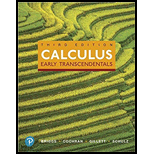
Concept explainers
Gliding mammals Many species of small mammals (such as flying squirrels and marsupial gliders) have the ability to walk and glide. Recent research suggests that these animals choose the most energy-efficient means of travel. According to one empirical model, the energy required for a glider with body mass m to walk a horizontal distance D is 8.46 Dm2/3 (where m is measured in grams, D is measured in meters, and energy is measured in microliters of oxygen consumed in respiration). The energy cost of climbing to a height D tan θ and gliding a distance D at an angle θ below the horizontal is modeled by 1.36 m D tan θ (where θ = 0 represents horizontal flight and θ > 45° represents controlled falling). Therefore, the function
gives the energy difference per horizontal meter traveled between walking and gliding: If S > 0 for given values of m and θ, then it is more costly to walk than glide.
- a. For what glide angles is it more efficient for a 200-gram animal to glide rather that walk?
- b. Find the threshold function θ = g(m) that gives the curve along which walking and gliding are equally efficient. Is it an increasing or decreasing function of body mass?
- c. To make gliding more efficient than walking, do larger gliders have a larger or smaller selection of glide angles than smaller gliders?
- d. Let θ = 25°, (a typical glide angle). Graph S as a function of m, for 0 ≤ m ≤ 3000. For what values of m is gliding more efficient?
- e. For θ = 25°, what value of m (call it m*) maximizes S?
- f. Does m*, as defined in part (e), increase or decrease with increasing θ? That is, as a glider reduces its glide angle, does its optimal size become larger or smaller?
- g. Assuming Dumbo is a gliding elephant whose weight is 1 metric ton (106 g), what glide angle would Dumbo use to be more efficient at gliding than walking?
(Source: Energetic savings and the body size distribution of gliding mammals, R. Dial, Evolutionary Ecology Research 5, 2003)
Want to see the full answer?
Check out a sample textbook solution
Chapter 4 Solutions
CALCULUS:EARLY TRANSCENDENTALS-PACKAGE
Additional Math Textbook Solutions
Introductory Statistics
Thinking Mathematically (6th Edition)
A Problem Solving Approach To Mathematics For Elementary School Teachers (13th Edition)
A First Course in Probability (10th Edition)
Elementary Statistics (13th Edition)
Basic Business Statistics, Student Value Edition
- 4. Evaluate the following integrals. Show your work. a) -x b) f₁²x²/2 + x² dx c) fe³xdx d) [2 cos(5x) dx e) √ 35x6 3+5x7 dx 3 g) reve √ dt h) fx (x-5) 10 dx dt 1+12arrow_forwardI just need help with evaluating these limits.arrow_forward3. Differentiate the following functions. Show your work where applicable. a) y = e³x b) f(x)=2 cos(5x) c) y = 1 - 2 d) y = In|secx| e) f(t) = t² e√t f) f(x) = 1+x x sin x 3arrow_forward
- Rylee's car is stuck in the mud. Roman and Shanice come along in a truck to help pull her out. They attach one end of a tow strap to the front of the car and the other end to the truck's trailer hitch, and the truck starts to pull. Meanwhile, Roman and Shanice get behind the car and push. The truck generates a horizontal force of 377 lb on the car. Roman and Shanice are pushing at a slight upward angle and generate a force of 119 lb on the car. These forces can be represented by vectors, as shown in the figure below. The angle between these vectors is 20.2°. Find the resultant force (the vector sum), then give its magnitude and its direction angle from the positive x-axis. 119 lb 20.2° 377 lbarrow_forwardAn airplane flies due west at an airspeed of 428 mph. The wind blows in the direction of 41° south of west at 50 mph. What is the ground speed of the airplane? What is the bearing of the airplane?arrow_forwardA vector with magnitude 5 points in a direction 190 degrees counterclockwise from the positive x axis. Write the vector in component form, and show your answers accurate to 3 decimal places.arrow_forward
- ||A||=23 45° Find the EXACT components of the vector above using the angle shown.arrow_forwardGiven ƒ = (10, -10) and q = (-8, −7), find ||ƒ— q|| and dƒ-9. Give EXACT answers. You do NOT have to simplify your radicals!arrow_forwardFind a vector (u) with magnitude 7 in the direction of v = (2,4) Give EXACT answer. You do NOT have to simplify your radicals!arrow_forward
- Algebra & Trigonometry with Analytic GeometryAlgebraISBN:9781133382119Author:SwokowskiPublisher:Cengage
 Glencoe Algebra 1, Student Edition, 9780079039897...AlgebraISBN:9780079039897Author:CarterPublisher:McGraw Hill
Glencoe Algebra 1, Student Edition, 9780079039897...AlgebraISBN:9780079039897Author:CarterPublisher:McGraw Hill Functions and Change: A Modeling Approach to Coll...AlgebraISBN:9781337111348Author:Bruce Crauder, Benny Evans, Alan NoellPublisher:Cengage Learning
Functions and Change: A Modeling Approach to Coll...AlgebraISBN:9781337111348Author:Bruce Crauder, Benny Evans, Alan NoellPublisher:Cengage Learning


